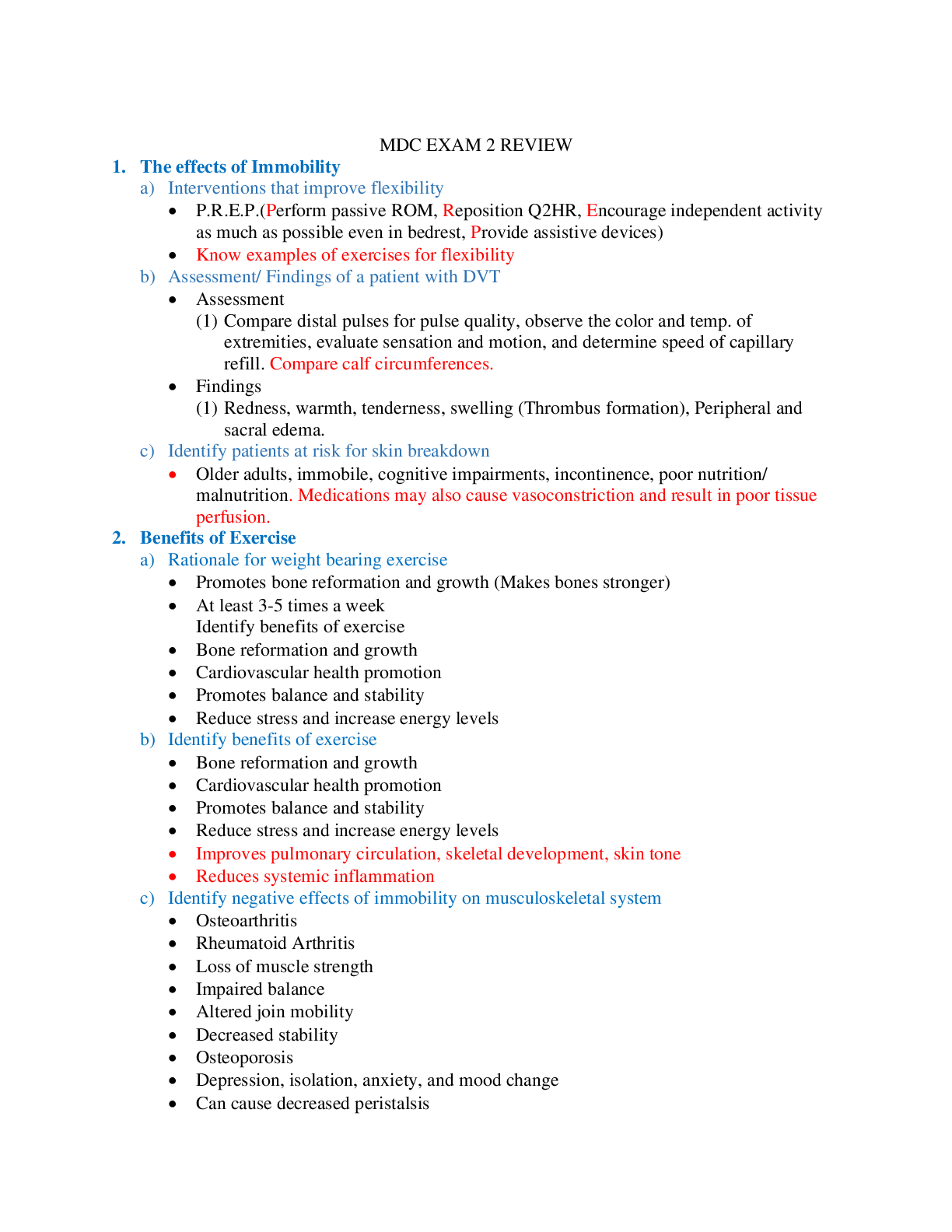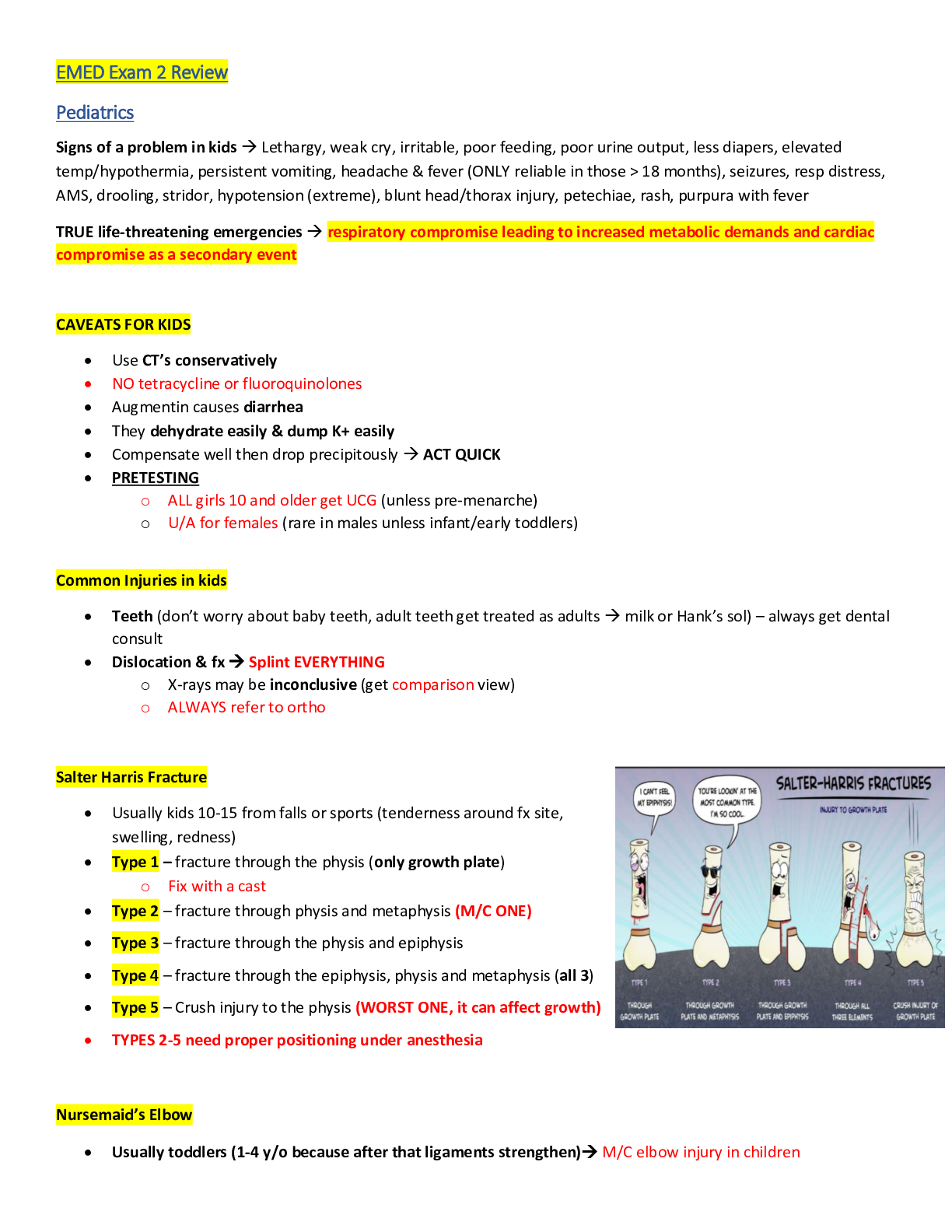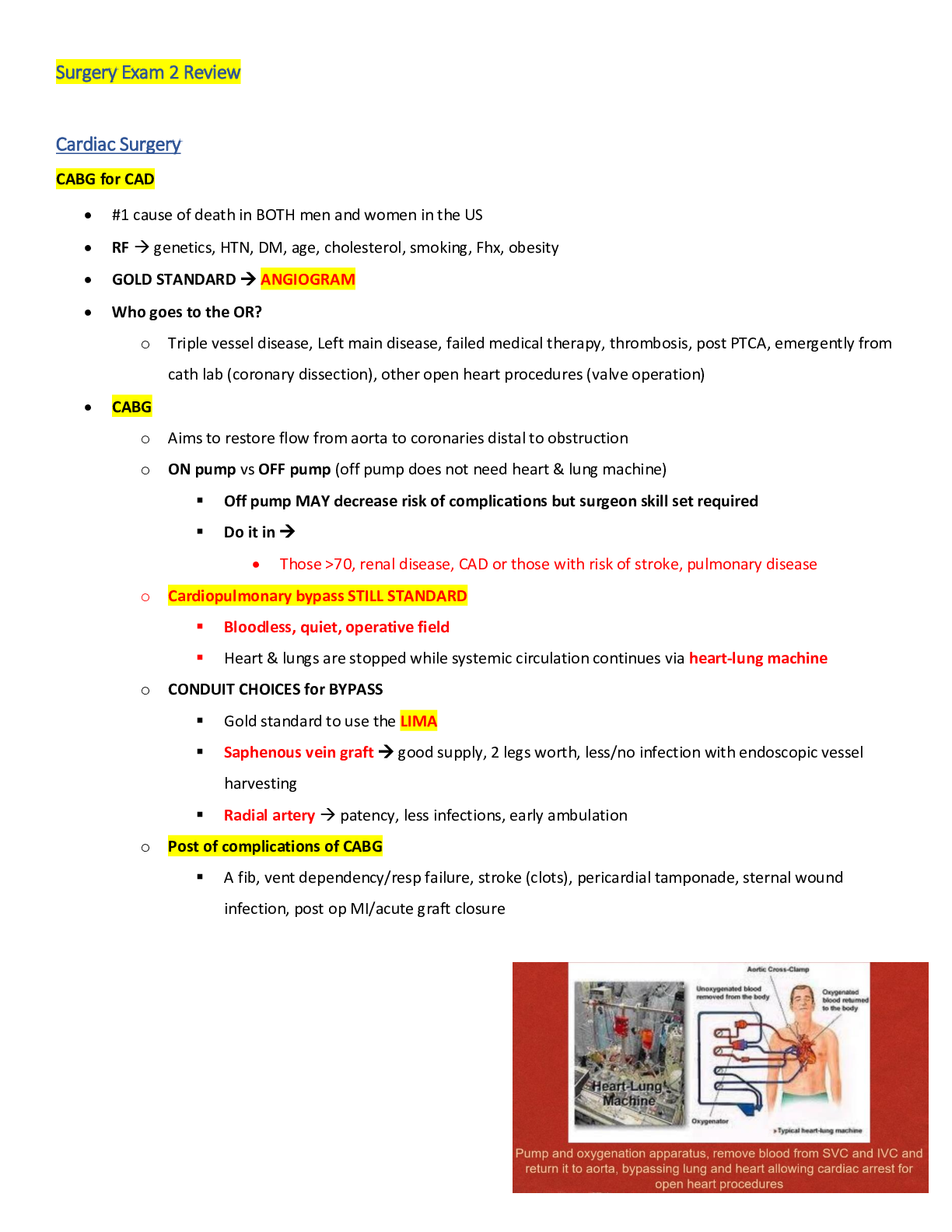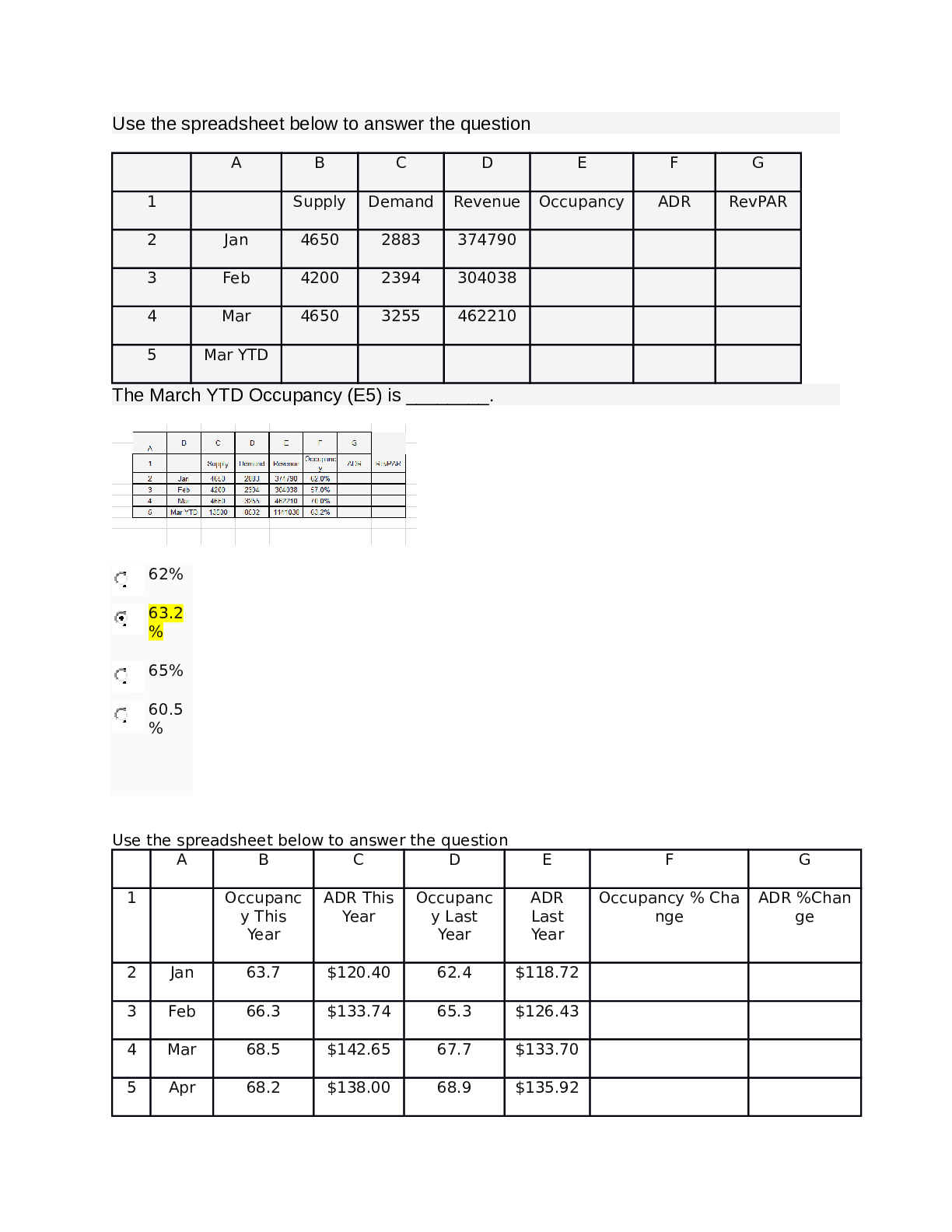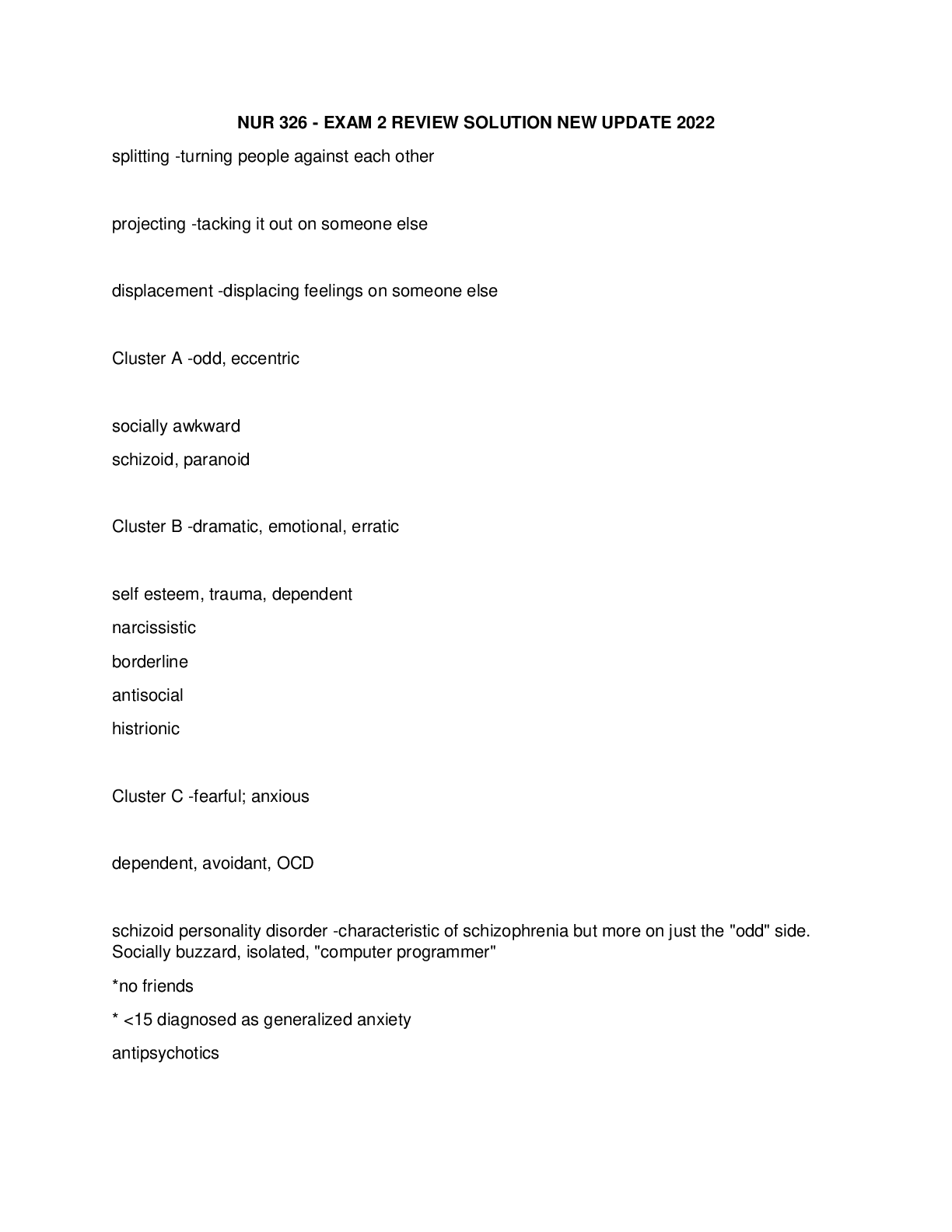*NURSING > EXAM REVIEW > ANTH 160A Exam 2 Review LATEST Completed and Graded A (All)
ANTH 160A Exam 2 Review LATEST Completed and Graded A
Document Content and Description Below
Exam #2 Review (Anth106) Chapter 6: • Summary: • Upper paleolithic & Late Stone Age, we see ochre rods, shell beads, engraved ostrich shells, simple pendants • Culture is characterized by: ... • production of blade tools • broadening of a subsistence base • increase in the size of some sites (because of practice of temporary population aggregation) • use of bone, antler, ivory, and shell in tool making • items of personal adornment • extensive use of nonlocal exotic raw materials • grave goods in burial • first appearance of artwork (naturalistic paintings, fanciful sculptors, engraved bone/antler) • Key terms: • Aurignacian: blade tools; lithic; 40,000 years ago • grave goods • Gravettian: small blades; Upper Paleolithic; 27,000 — 21,000 • logistical collecting • Magdelanian • megafauna • mobiliary art • opportunistic foragers • parietal art • petroglyph • settlement pattern • Solutrean • spear-thrower • Venus figurine • Multiple Choice • 50,000 anatomically modern humans looked like us but didn't think like us • 77,000 BP Blombos Cave: unequivocal evidence for art as symbolic expression • Increasing importance of flake tools doesn't represent a discontinuity between the Middle and Upper Paleolithic and the Middle and Late Stone Age period • Solutrean: tradition featuring finely made, leaf shaped stone blades; • Magdelanian: tradition emphasizes bone and antler work • Burin tool: engraving tool • Upper paleolithic tool technologies changed rapidly compared to Middle Paleolithic • Megafauna: Large, extinct herbivores of the Pleistocene era • Opportunistic foraging involves little planning • Spear-thrower: tool that extends the length of the arm; allows for better accuracy and distance when throwing a spear• Personal adornment could have possibly meant increasing awareness and importance of individual identity • Australia: features the earliest evidence of etching into a rock face • Petroglyph: design that is not painted upon but is etched into a rock face • Cave paintings are an example of parietal art • Venus figurines are mostly found in Europe • Grave goods buried with children at Sungir = tribe had complex system of inherited social statuses • Grandmother effect: decrease in child mortality associated with the presence of older generations • Logistical collecting: subsistence strategy and settlement pattern based on seasonality and planned acquisition of resources • Upper Paleolithic is associated with: • New/improved stone tool tech • broadening of the subsistence base • larger sites with increased populations • Chapter 7 • Summary: • Late Pleistocene: expanding human population and migrated into Australia, North America, and South America • Australia populated by costly adapted southeast Asians • Possible use of watercraft • Later moved pacific into Borneo, Sulawesi and Timor then into Greater Australia • New Guinea, Tamania, and Australia proper (40,000 years ago; lower sea level) • First settlers: tropical/coastal orientation; slowly turned inland; • New World was connected to Old World during Pleistocene by land brig • Allowed for interior dwelling people in NE Asia to travel to NW of America • Monte Verde (Chile): LOOK UP; Meadowcroft Rockshelter (Penn State) • Both show evidence of using land bridge (20,000 Years ago) • Possible movement through ice-corridor into American West • Clovis people: LOOK UP; First successful occupation in the New World • Multiple choice: • Sundra: Java, Sumatra, Bali, Borneo • Sahul: Landmass connecting Australia, New Guinea, and Tasmania • Wallace Trench: undersea chasm between New Guinea/Australia and Java/Borneo • Evidence dates occupation in Australia as far back as 60,000 years ago • Arch. agree on occupation in Australia no earlier than 40,000 • Aborigines occupied the harsh interior of Australia 20,000 — 25,000 years ago • New Zealand was last occupied by humans • Climate of Greater Australia 20,000 years ago was temperate, hot/dry, frozen tundra • Native navigators of the Pacific were familiar with currents and wind patters, cloud patters, bird flight paths • Lapita designation is applied to Polynesia because of pottery style • Bering Strait was above water off/on 35,000 — 11,000 • Clovis: stone blade showing a flute point on both faces and associated with elephants • Denali Complex: lithic technology seen in the Arctic and had wedge-shaped cored, micro blades, bifacial knives, and burins • Cordilleran: Ice mass in North America centered in the Rocky Mountains • Gault site: Texas; 13,000 years ago that Paleoindians chose this location because of how close it was to local source of chert for quarrying and making stone tools • Key terms: • Beringia (or Bering Land Bridge) • burin • Clovis • Cordilleran • Denali Complex • fire-cracked rock • fluted point • Folsom• gracile • haplogroup • ice-free corridor (or McKenzie corridor) • Lapita • Laurentide • Melanesia • microblade • Micronesia • Nenana Complex • Paleoindian • Polynesia • Pre-Clovis • Sahul • Sunda (or Sundaland) • Wallacea • Wallace Trench • wedge-shaped core Chapter 8 • Summary: • Europe, Asia, North/South America, Australia, and Africa: intensification of food collection, increasing economic/social complexity, and marked jump in regional cultural diversity • 12,000 BP: changes in Pleistocene environments which they became adapted to • ice=exposed; temperatures rose, more wet areas and more dry areas too • Plants were available and could be used as nuts, seeds, fruits, etc • Cultural diversity increased greatly • Some settlements became more permanent and population grew; food quest intensified because they wanted to increase of the productivity • Multiple Choice: • Late Pleistocene and early Holocene climate: fluctuating significantly but growing progressively warmer • The Younger Dryas: was a period of glacial expansion • Mesolithic: Lies between Paleolithic and the Neolithic • Early Mesolithic Maglemosian was adapted to a forest and lakeside environment • Midden: preserved pile of trash; Mattock: digging tool with a working blade set • Trade patterns in Mesolithic vs Upper Paleo: Mesolithic goods traveled less but there was more exchanging • Subsistence strategy of the North America Archaic period: Greater regional differentiation • Dependence on foraging for this subsistence • 12,000 years ago: humans began controlling their food sources by artificially producing • Artificial selection: direct breeding of plants and animals • 10,000 Goat domesticated in the Middle East • Maize, beans, and squash provided subsistence base for indigenous New World • Maize appears in Southwest America 3500 BP and 1800 BP in the east • According to human DNA, origin of the first European farms were migrated from Asia and brought domesticated plants and animals Chapter 9 • Summary: • Shift from simple/social organization to complex framework • Fueled by the need to organize a large group of people to increase food production (watercontrol) • Social/politcal structure to organize monumental projects • Burials show the creation of ranks/classes • Jerico and Catalhoyuk: LOOK UP • Mesopotamia: Olmec • 4,500 BP: Peru (Caral): found clusters of enormous, flat topped pyramids • Keys terms: • Chavin • chiefdom • complex society • Halafi an • Hassunan • lintel • megalith • Mesopotamia • Olmec • Poverty Point Culture • Regal-Ritual Centers • Samarran • sarsen • tholoi • trilitho • Multiple choice: • Stonehenge: • upright stone=sarsens; horizontal stone=lintels • megalithic monument • had knowledge about: political complexity, grasp of basic engineering, and organization of labor • Agriculture allows for complexity because it only takes a few people to feed which allows for freeing up enormous labor potential • Rank societies are dominated by big men • Chiefdom is more complex than a tribe but less complex than a state • Olmec Culture • Elite class: those who lived near resource privileged areas • Consisted of loosely affiliated chiefdoms • religious iconography was a unifying element • Produced the earliest writing in the New World • Caral site: Development of a complex society was shown because of the building of canals • First metal used in South America: Gold & copper• 3100 BP: first evidence of metals in South America (hammering) • Unifying element of Chavin culture: artistic style showing similar creatures, woven textiles • Jericho showed development of a complex society • Catalhoyuk was considered a village and not a city because there were no palaces, public architecture, and had little evidence of status diff. Chapter 10 • Summary: • Neolithic set the stage for farming in the Old World • Cultural complexity in some regions led to social systems • Controlled excess wealth • Social elites developed for reorganization for orderly/systematic trade; aggregation canals for food base • New way of organizing/controlling was utilizing was by the developing elite to contract less practical monumental works (temples, palaces, pyramids) • Large monuments = dramatic evidence that showed the power of the elite • What led to civilization was in Mesopotamia, in the Middle East, Nile Valley, and Sudan • Key terms: • Amratian/Nagada I • city-state • civilization • class society • cuneiform • dagga • deffufa • envelope • hieroglyphic • Integration and Conflict • Knossos • Kush • Late Gerzean (Nagada II, Maadian) • Mastaba • Minoan • Mycenaeans • monumental work • Nagada III • New Temple Period • Nubia • Omari A • social stratification • specialization of labor • state • system of record • keeping • token • tumuli • Ubaid • Uruk Period • Ziggurat• Multiple choice: • State society: stratified society whose rulers have the power to tax/make laws/conscript labor • Social system: pattern in which people are placed into hierarchy of social levels • Specialization of labor: can only exist in a society with food surplus, sophisticated craft work, and characteristic of civilized societies • Mesopotamia: worlds first civilization developed • Temple in Mesopotamia: set apart and had powers before social complexity • Uruk, population of 10,000 • Mesopotamia: style of writing was cuneiform (6,000 years ago) • Egypt: Hieroglyphics styles of writing • Upper Egypt (south) & Lower Egypt (north) • First pharaoh in Egypt was 5100 BP • Ruled 3 million people who were 75% farmers • Greatest pyramid built: Snefuru and his son Khufu • Conflict models: importance of internal tensions in state societies • Integration models: external tensions Jeopardy • Near East and Egypt • Animals/plants in the near eastern Neolithic that were domesticated: • Wheat, barley, rye, goats, sheep, cattle • Farming site that traded obsidian and had a “cattle cult” shrine • Catalhoyuk • Abu Hureyra occupation • Pre-pottery Neolithic (10,000 — 6,000 BC) • Younger Dryas • 1,000 year long period of cold in Southwestern Asia; began 10800 BC; cooler/dyrer • Europe • Large stones used in Stonehenge • Megaliths • Agriculture spread from The Fertile Crescent (by Mesopotamia) • Ritual expression (Europe vs. Near East) • Near East: secularized and were in households • Europe: public and community oriented • Asia and the Pacific • Oldest pottery-making culture in the world (Japan) • Jomon (10,500 BC) • Pottery widespread through Melanesia, Micronesia, and Polynesia • Lapita (geometric lines) • Other • Dogs were the first domesticated 15,000 BP • Three changes that occurred with the shift to agriculture • Changes in social structure (inequality, competition) • Technological changes (mircoliths, bow and arrow) • Population increase • Cultivation: intentional relationships with plants and animals• Domestication: Genetic modification of plants and animals • Holocene: 12,000 BP — Present • Ecological changes: warming trend; seasonality, areas that were inhabited with ice are no habitable, megafaunal extinctions • [Show More]
Last updated: 1 year ago
Preview 1 out of 11 pages

Reviews( 0 )
Document information
Connected school, study & course
About the document
Uploaded On
Apr 25, 2021
Number of pages
11
Written in
Additional information
This document has been written for:
Uploaded
Apr 25, 2021
Downloads
0
Views
83





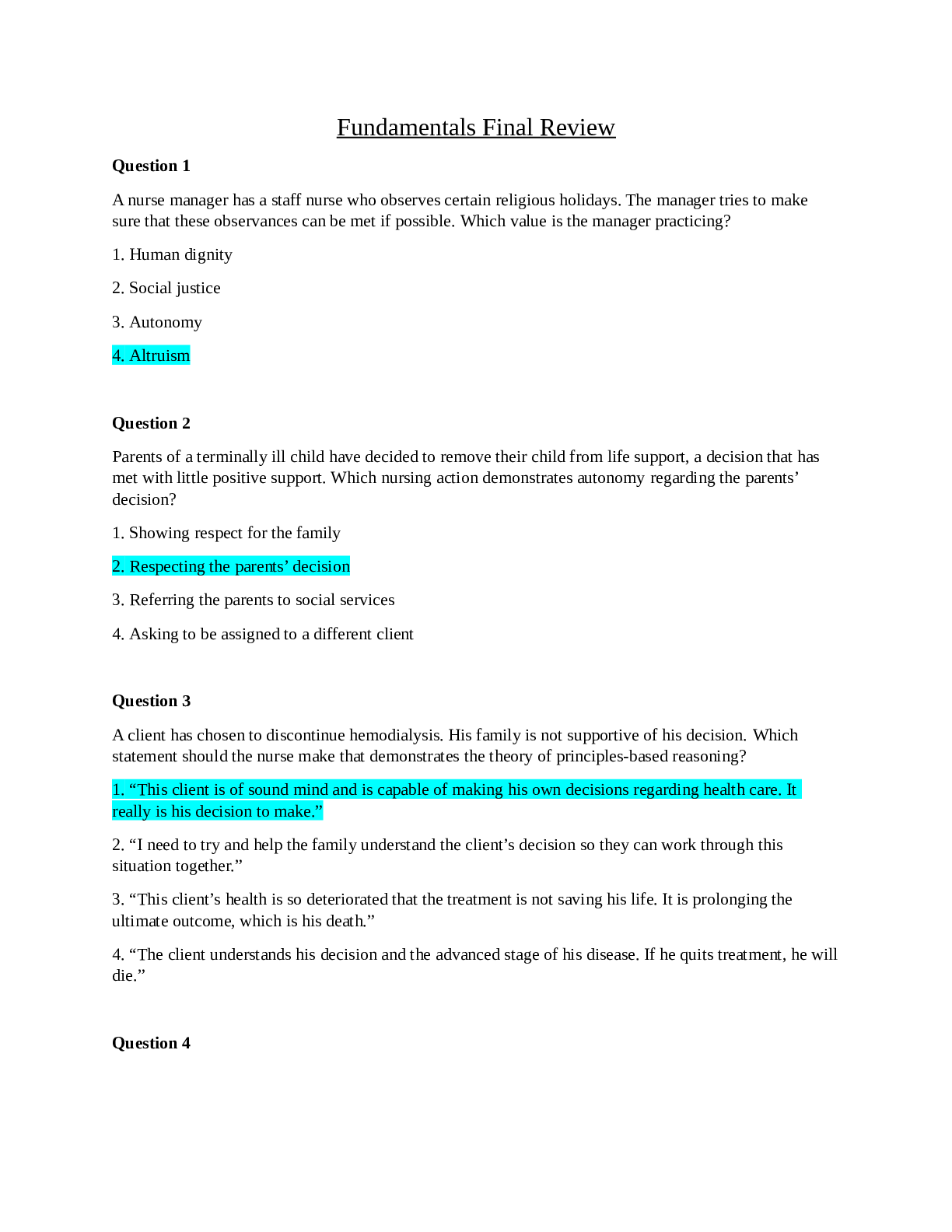


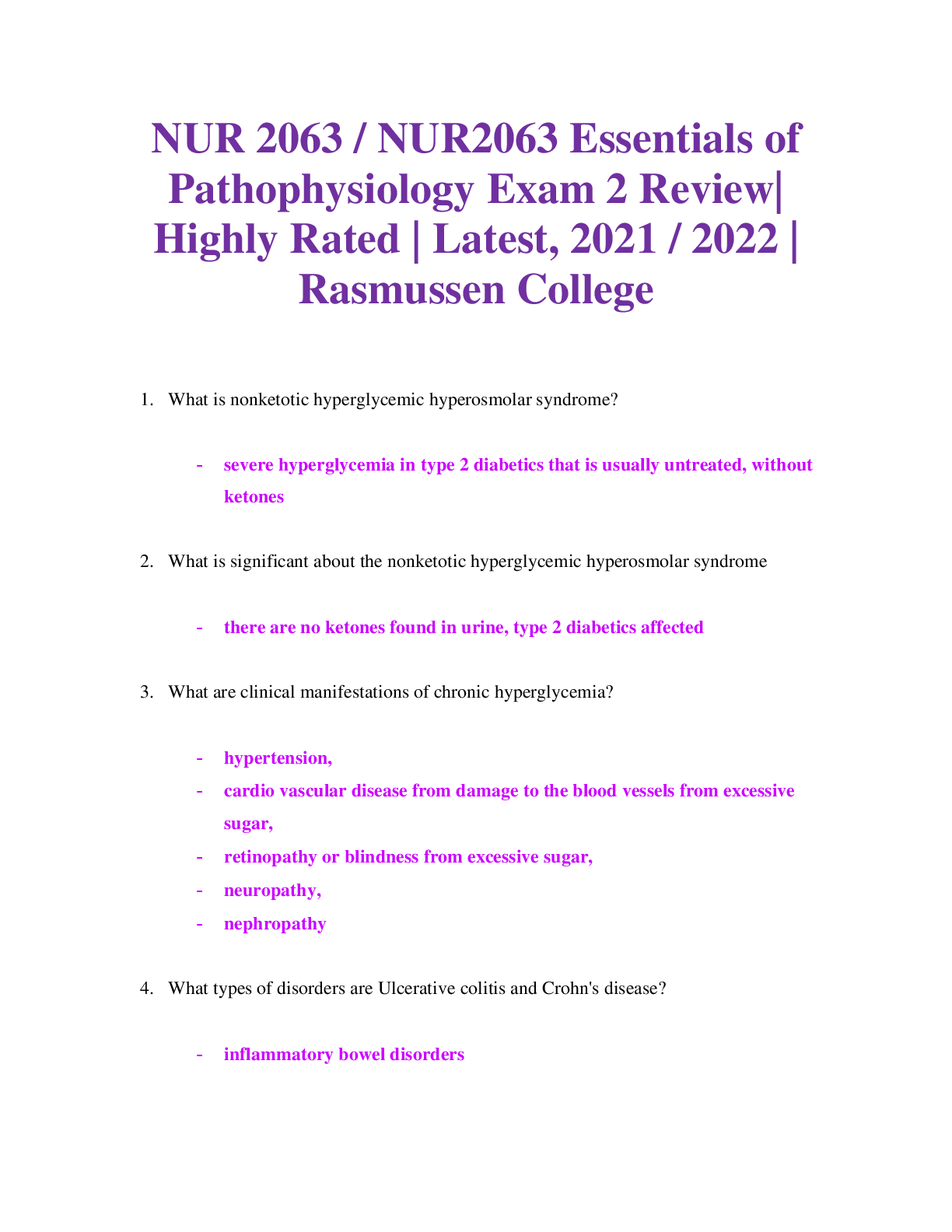

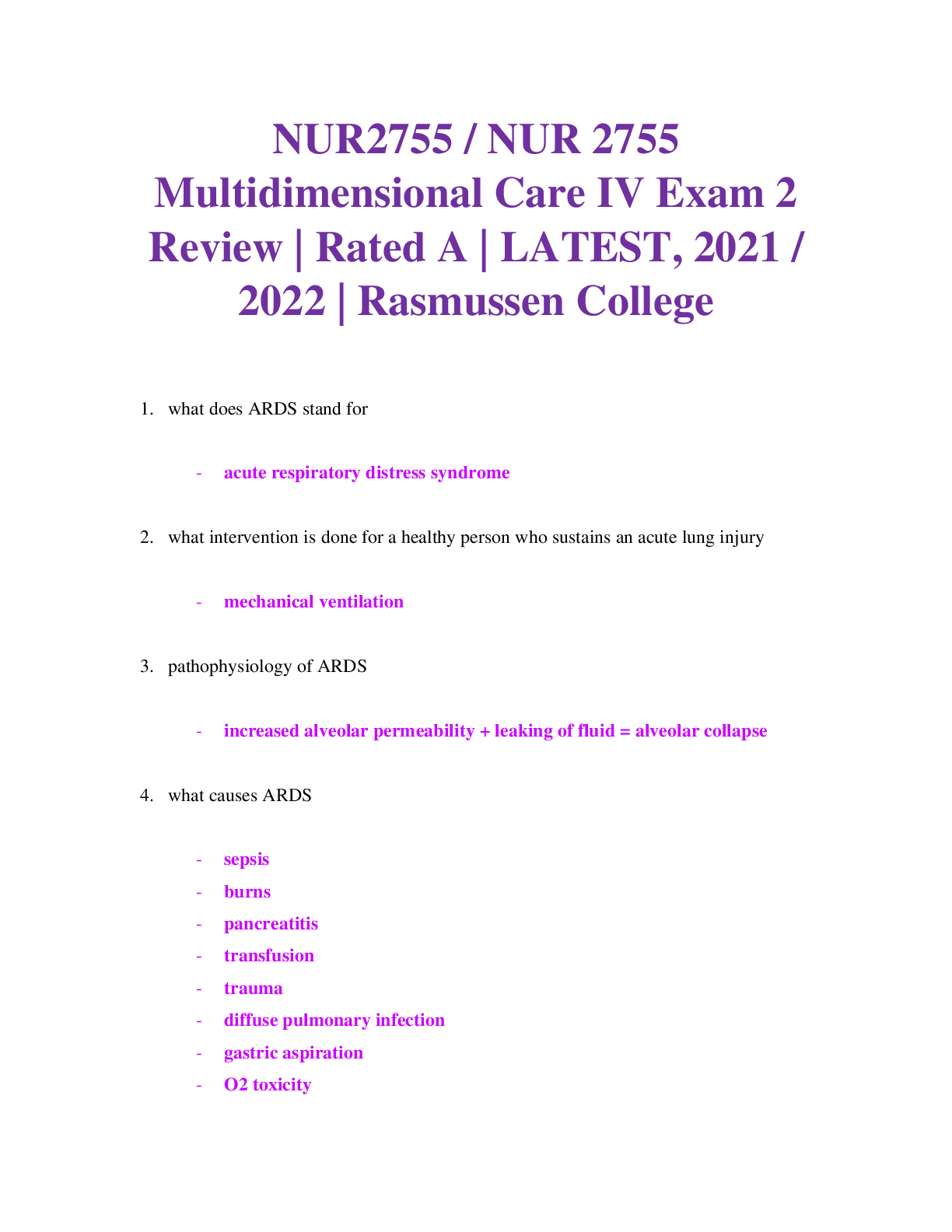
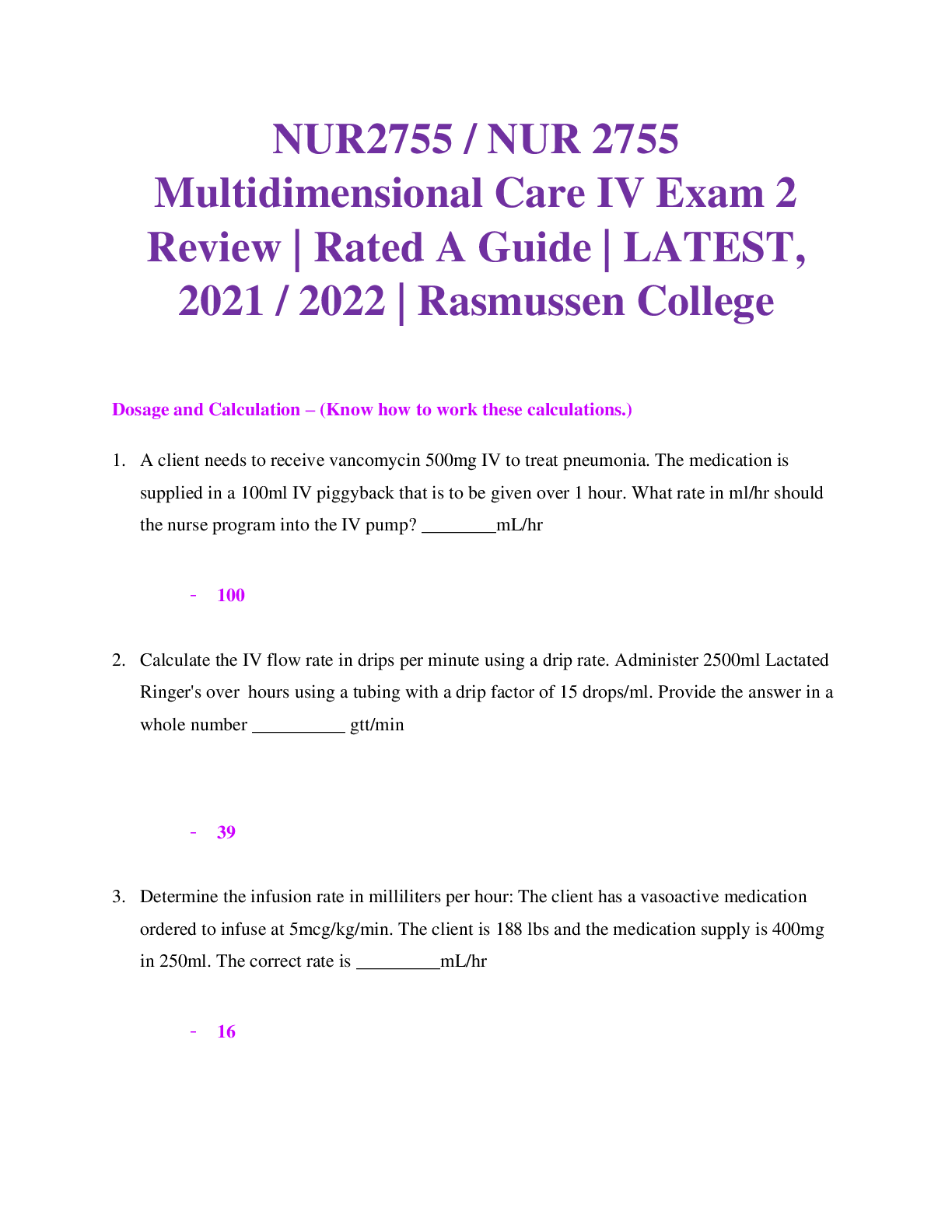




.png)

